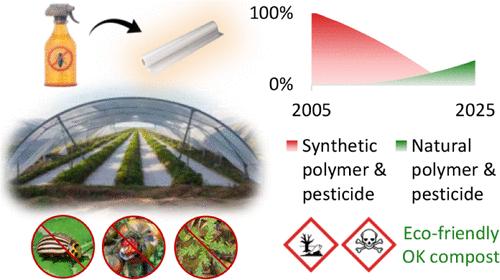可持续作物保护的农药功能化塑料栽培:系统综述
IF 6.2
1区 农林科学
Q1 AGRICULTURE, MULTIDISCIPLINARY
引用次数: 0
摘要
农作物面临着来自动物害虫、病原体和杂草的重大生物压力,推动了农药和塑料栽培的广泛使用。虽然合成农药危害环境和人类健康,但生物农药的稳定性有限。塑料养殖并不是完全防虫的,它依赖于化石聚合物。生物聚合物替代品正在出现,但需要改进物理性能。农药功能化塑料作为害虫的物理化学屏障,提高农药的稳定性,减少环境释放,改善聚合物性能,提供了一个很有前途的解决方案。这篇综述强调了在环境问题和生物农药和生物聚合物的进步的推动下,人们对这种方法的兴趣越来越大。这些系统以低剂量有效地控制害虫。功能化也能改善聚合物的性能──包括透光性、疏水性、延展性和热稳定性──尽管它可能会减缓生物降解。进一步的研究应加强生物农药与聚合物的相容性,优化长效剂量,评估环境影响,并为可持续作物保护开发完全生物基、可生物降解的材料。最后,不断增长的需求有望降低这些新型环保材料的成本。本文章由计算机程序翻译,如有差异,请以英文原文为准。

Plasticulture Functionalized with Pesticides for Sustainable Crop Protection: A Systematic Review
Crops face significant biotic stress from animal pests, pathogens, and weeds, driving widespread use of pesticides and plasticulture. While synthetic pesticides harm the environment and human health, biopesticides have limited stability. Plasticulture is not fully insect-proof and relies on fossil-based polymers. Biopolymer alternatives are emerging but require improved physical properties. Pesticide-functionalized plastics offer a promising solution by acting as a physical-chemical barrier against pests, enhancing pesticide stability, reducing environmental release, and improving polymer properties. This review highlights growing interest in this approach, driven by environmental concerns and advances in biopesticides and biopolymers. These systems effectively control pests at low doses. Functionalization also improves polymer properties─including light transmission, hydrophobicity, ductility, and thermal stability─though it may slow biodegradation. Further research should enhance biopesticide-polymer compatibility, optimize doses for long-lasting efficacy, assess environmental impacts, and develop fully biobased, biodegradable materials for sustainable crop protection. Finally, growing demand is expected to lower the cost of these new eco-friendly materials.
求助全文
通过发布文献求助,成功后即可免费获取论文全文。
去求助
来源期刊
CiteScore
9.90
自引率
8.20%
发文量
1375
审稿时长
2.3 months
期刊介绍:
The Journal of Agricultural and Food Chemistry publishes high-quality, cutting edge original research representing complete studies and research advances dealing with the chemistry and biochemistry of agriculture and food. The Journal also encourages papers with chemistry and/or biochemistry as a major component combined with biological/sensory/nutritional/toxicological evaluation related to agriculture and/or food.

 求助内容:
求助内容: 应助结果提醒方式:
应助结果提醒方式:


